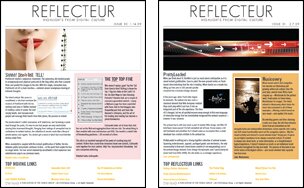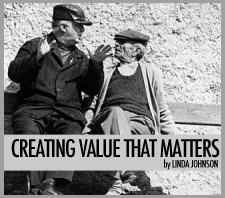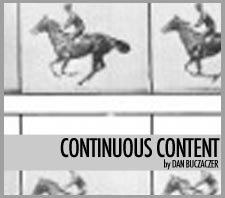REFLECTING ON ONE YEAR OF REFLECTEUR
Posted by Christian Kugel | February 13, 2009
Last month we celebrated the first anniversary of Reflecteur, a product we created to help us understand digital culture. The modern marketplace is one that increasingly is shaped by digital culture – how people use digital platforms to connect with each other, share with like-minded people, express themselves, and find entertainment, among other tasks.
So, a year ago, we launched Reflecteur to help us keep track of this continually-evolving area. Here’s a quick overview of how Reflecteur works:
1) Everyone in Denuo participates in this step. We use a social bookmarking platform to flag digital behaviors, content and environments that speak to an insight regarding digital culture.
2) Every two weeks, we hold an open editorial meeting, where we go through the bookmarked content and discuss what we believe are the underlying insights for the contender topics.
3) The core team then writes a one-page brief for the publication, which essentially maps out that week’s issue.
4) Last step is production – writing the articles, layout, photos/graphics, etc.
By its very nature, we didn’t design Reflecteur to answer any one particular question relating to a campaign or project. We instead designed it to keep us honest – to ensure that we were not relying on our intuition regarding macro digital culture trends. We use qualitative ethnographic techniques (we don’t use quantitative data to power Reflecteur) to determine the insights behind what we write about. But we do this in a systematic and disciplined way, which has delivered quality insights.
So how do we use it? Simply put, Reflecteur helps us to continually course-correct our understanding of digital culture and calibrate our sensitivity to it. When we develop strategies, campaigns or ideas for clients, that work is informed by cultural insights – which are uncovered from the collective wisdom of Denuo.
As Reflecteur project leader, I’ve learned a ton over the past year:
1) Have the courage to make drastic course corrections. Before we implemented our ‘crowdsourcing’ technique, we used a different technique based on automated CGM listening. It didn’t work well at all, and we had to hit reset. We admitted that our first stab at it wasn’t successful, we then created a new plan, and I’ve been very happy with the new approach.
2) Model the process on Web 2.0 principles. We don’t have ‘versions’ of Reflecteur or a calendar for making scheduled improvements. When we have an idea, we implement it, try it out and decide if we like it. When we launched Reflecteur, we had a more rigid process. As we migrated to a more fluid process the quality of Reflecteur has increased.
3) Listen. It seems ironic, but I’m convinced that people like me, who were trained in formal market research, aren’t naturally attuned to truly listening. We’re too focused on what we are going to say next to prove our argument. With Reflecteur, I purposely rejected that and made the entire process open to everyone in Denuo. Anyone can contribute, and everyone has. The best ideas for Reflecteur have come from people with very different skill sets – Anisha, Sarah and Katie.
4) Repurpose the IP. In addition to publishing Reflecteur, twice a year we aggregate the insights and create a presentation. These Insights from Reflecteur presentations are a great way to engage our clients and be thought leaders. The IP has already been created – but by aggregating it and repackaging it, we extend the value of it.
If you’re interested in seeing examples of our publication, check it out here and here. Would love to hear what you think. Email me at christian.kugel-at-denuogroup.com.
Related Posts
- REFLECTEUR – Issue 91
- REFLECTEUR – Issue 64
- REFLECTEUR – Issue 67
- REFLECTEUR – Issue 73
- REFLECTEUR – Issue 81
Leave a Comment
RSS feed for comments on this post · TrackBack URI


